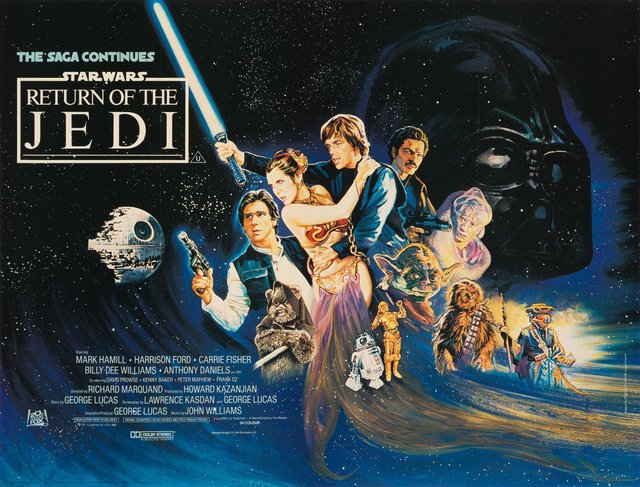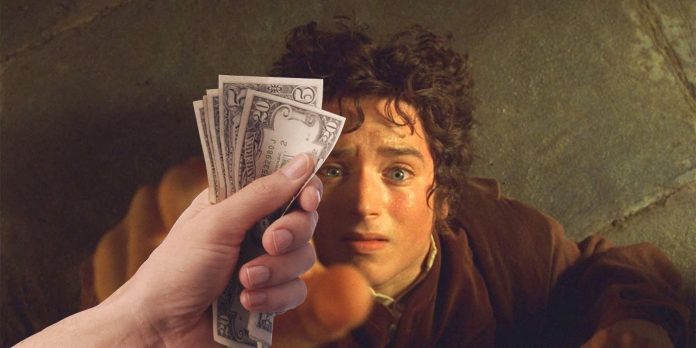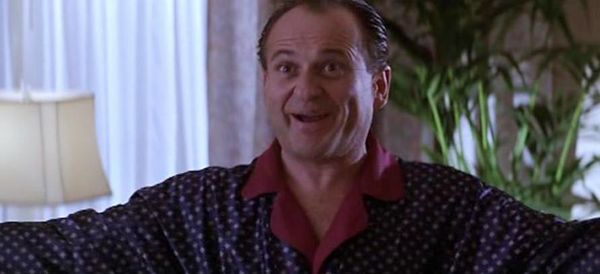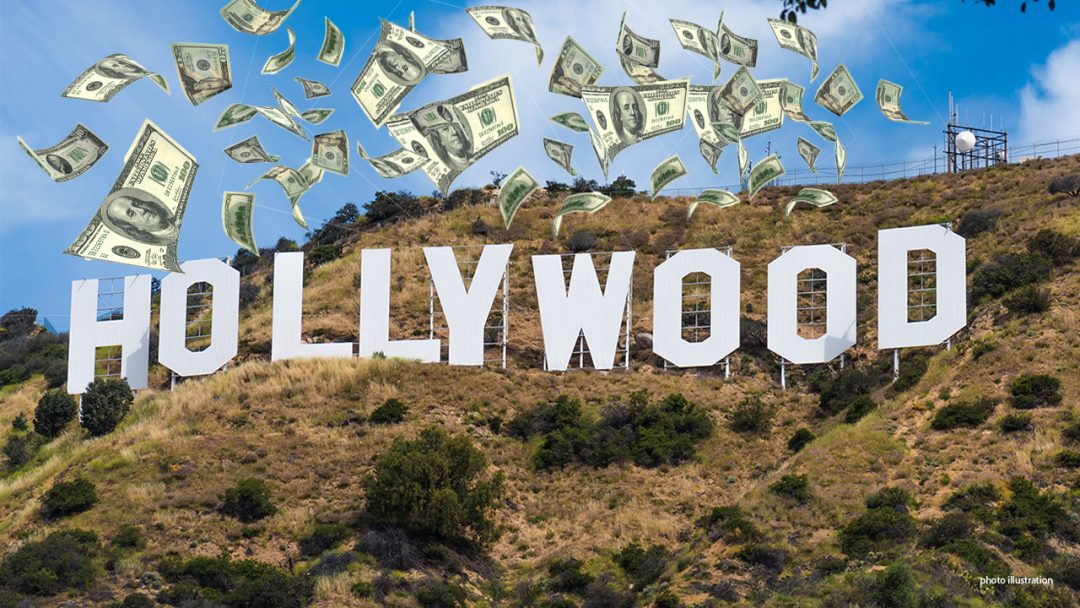Hollywood History is back at Last Movie Outpost. Once more we manage to resurrect something from our past life. This was one of our most discussed, and most shared articles and the single biggest reason we don’t get invited to anything. We delve into the murky depths of movie money and the hidden, borderline-criminal world of Hollywood Accounting.
Did you know that Return Of The Jedi made a loss? Incredibly it is still making a loss. Despite having earned $475 million in 1983 dollars at the box office against a budget of $32.5 million the movie has never turned a profit. It is officially still a loss-making movie. That is with a box office take worth $1,340,393,235 today.

This is due to the wonders of Hollywood accounting. This is the opaque or creative accounting used by the film, video, and television industry to budget and record profits for film projects.
Expenditures can be inflated to reduce or eliminate the reported profit of the project, thereby reducing the amount that the corporation must pay in taxes and royalties or other profit-sharing agreements, as these are based on the net profit.
Monkey Points
Basically, studios are completely free to insert arbitrary overheads into the cost profile at any point in the value chain, thus reducing the end profitability of any project. It is why, as Wonder Woman herself, Lynda Carter, said on the Joan Rivers Show many years ago:
“Don’t ever settle for net profits. It’s called ‘creative accounting’.”
Nobody would sign up for bonus points on the back end, based on net profits, as there very rarely are any. They even have a name, given to them by Eddie Murphy himself. Monkey Points. Murphy famously stated that only a monkey would sign up for points on net profit.
If you are a Hollywood big hitter, you insist on “gross points”. These are a percentage of gross revenue rather than net profit participation. Basically a slice of the box-office takings at the front, rather than monkey points at the back. This is why so many stars are also listed as Executive Producers. They are in for points.
Amazing isn’t it? While the entire industry virtue signals to maximum about every single social justice fashionable cause of the week, the entire thing is a huge tax evasion scheme, or a scheme to not pay their dues, and everyone is in on it. Incredible! Remember this next time one of them starts to lecture the normos on something.

Return Of The Jedi isn’t the only famous anomaly. Art Buchwald sued Paramount over Coming To America. That grossed at least $288 million on a budget of $35 million yet Paramount claimed it made no profit. The court found that this was highly unlikely and that Paramount’s actions were “unconscionable”.
Rather than open their books to independent forensic accounting, Paramount wrote a check to Buchwald for $900,000.
When you dig into this murky practice, you realize that it is far more widespread than anyone imagined. Some of our favorite movies have been impacted by this. It seems like a tentpole movie needs to have a lawsuit attached as if it is some kind of rite of passage.
The Greatest Hits Aren’t Hits
Recently, despite grossing $911 million against its $55 million budget, the 2018 Freddie Mercury biopic Bohemian Rhapsody was written down as a $51 million loss by the studio. Lawsuit triggered.
The 2002 film My Big Fat Greek Wedding was tagged as a huge success. It was a massive smash hit of an independent movie. Not so, if you believe the studio. They claimed that the movie, which cost less than $6 million to make and made over $350 million at the box office, lost $20 million. Lawsuit triggered.
Back in the late 80s and early 90s one of the biggest franchises on the block was Batman. Producers Michael Uslan and Benjamin Melniker sued Warner Bros claiming they were:
“…the victims of a sinister campaign of fraud and coercion that has cheated them out of continuing involvement in the production of the 1989 film Batman and its sequels. We were denied proper credits, and deprived of any financial rewards for our indispensable creative contribution to the success of Batman.”
The lawsuit was rejected despite the total revenues of the Batman franchise topping $2 billion. Warner Bros. offered the pair an out-of-court settlement. Uslan and Melniker’s attorney described the amount as equivalent to:
“…two popcorns and two Cokes”.
The hits that are not hits just keep on coming. Forrest Gump was a massive smash, right? Wrong! By the time the Hollywood accountants got hold of it, the movie made a net loss. Screenwriter Winston Groom was due a 3% share of profits. He got nothing outside of his initial fee as the movie didn’t make any money… apparently.
Writers seem to frequently be on the receiving end of these Hollywood accounting practices. Screenwriter Ed Solomon says that Sony still tells him that Men in Black is still a loss-maker despite a $600 million take on a $90 million budget.

One of the most famous cases was Stan Lee, co-creator of the character Spider-Man. His contract gave him 10% of the net profits of absolutely anything based on his characters. Toys, movies, games. The whole show.
Spider-Man (2002) made more than $800 million. However, it is officially listed as… you guessed it, a loss! A case was settled in January 2005 with Marvel paying out $10 million to Lee.
One of the most staggering examples of this is around a movie most would never guess didn’t turn a profit, according to the pinstripe suits in the halls of Hollywood. The Lord Of The Rings trilogy made $2.9 billion at the box office and nearly that again in television rights, home video release, re-release, merchandising, and special edition releases.
Yet according to New Line’s accounts, the trilogy made “horrendous losses” and turned no profit at all.
Jackson’s Wingnut Films has sued, and fifteen actors from the movie are still locked in legal action against New Line Cinema. They claim they have never received their 5% of revenue from merchandise sold in relation to the movie, which contains their likenesses.

Harry Potter is the third highest-grossing franchise of all time, behind only Star Wars and the Marvel Cinematic Universe. And yet Harry Potter and the Order of the Phoenix ended up with a $167 million loss on paper after grossing nearly $1 billion.
The Hollywood accounting in the Harry Potter case included a $60 million interest charge on a $400 million budget over two years – an interest rate far higher than the industry standard. Remember what we said about arbitrary costs inserted at any point in the value chain?
Bizarrely, this can work in either direction depending on what the studio needs the story to be. The 2005 film Sahara grossed $119 million against a production budget of $160 million, resulting in a $105 million loss for the studio. However, due to Hollywood accounting tactics, the loss was only reported as $78.3 million.
Basically, these people are crooks. CEOs and studio heads stand in investor calls and trumpet the staggering success of their movies, the talent of their creatives, and the power of their brands. Then the accountants send out accounts showing they are all crashing and burning at the back end.
If this was legitimate then clearly nobody would make movies for a living, and nobody would invest in entertainment at all. Yet they do, so it cannot be legitimate. If you believe the accounts, it is a truly terrible business model that almost never works.

What is it called when people take losses in order to preserve the cleanliness of their potential profits? Something about laundry? No wonder Hollywood and the Mob have always gone hand in hand.
Studios will argue that they never actually break any laws.
So How Do They Do It?
What are the mechanics of Hollywood accounting? Movie investment has long been held as a dirty route to tax evasion. Production-based schemes are frequently cited in court cases brought by various revenue enforcement agencies across the world when they prosecute tax evasion. Investors get caught, but the studios providing the engine room of this sordid business just keep on trucking.

These practices are so well known that they even have names.
One favorite is the Repo 105 scheme where several sub-entities are created to actually make the movie, and then they apply arbitrary charges against each other for things like professional fees and service provision fees to wipe out profits.
The Subsidiary Scheme is similar and at the heart of most of these Hollywood accounting practices. A network of subsidiaries is formed to perform a certain activity and then the parent company extracts charges from them for all the goods and services used in the movie and even for professional fees.
Say a movie studio sets up a distribution arm as a sub-entity. The entity will then charge the studio a distribution fee. The studio has basically just charged itself for doing its own essential role in the movie-making value chain – distributing the damn movie. It is charging itself a fee that it has total control over that it can inflate as much as it wants in order to drive down the profitability of the project, while keeping ALL the cash.
Another is known as the Reverse Tobashi Scheme. In this, a movie studio combines two projects or productions together, allowing them to shift accounting between the two, moving profit or loss across them as required. They shift losses from a flop onto a profitable project by shifting costs via internal accounting internal operations.
This makes project “A” not as bad a loss but drives down the profitability of project “B” so they don’t have to pay out as much in net points and tax. If it works properly then two unprofitable projects are created on paper and all net participation liabilities evaporate.
Sneaky bastards!

It is all in the overhead. Studios basically make up their own costs and apply these to their productions. Any accountant would look at these overheads and laugh at loud when benchmarking the costs of these overheads against similar on the open market, outside of Hollywood.
Why do you think movies like Mission Impossible 7 cost $300 million when they were half that a decade ago? Nobody on the production, from wardrobe assistants to VFX artists has received anything like that percentage via a massive pay rise. Inflation isn’t that high, regardless of the best efforts of the Biden administration.
- Load in Production overhead – Studios, on average, calculate production overhead by using a figure of around 15% of total production costs.
- Load in Distribution overhead – Film distributors typically keep 30% of what they receive from movie theaters (“gross rentals”).
- Load in Marketing overhead – To determine this number, studios usually choose about 10% of all advertising costs.
Then wrap this all up in a network of subsidiaries all charging each other what they like for all of this, and every movie can be made to make a loss on paper.
There was recently a story out there that No Time To Die, when the dust settles, will make a loss. Maybe it will, but nobody up the food chain on that movie will fail to be handsomely rewarded. This is just how Hollywood Accounting works.
TL: DR – Drunken Yoda liked this article so much, he turned it into a video.
Check back every day for movie news and reviews at the Last Movie Outpost







